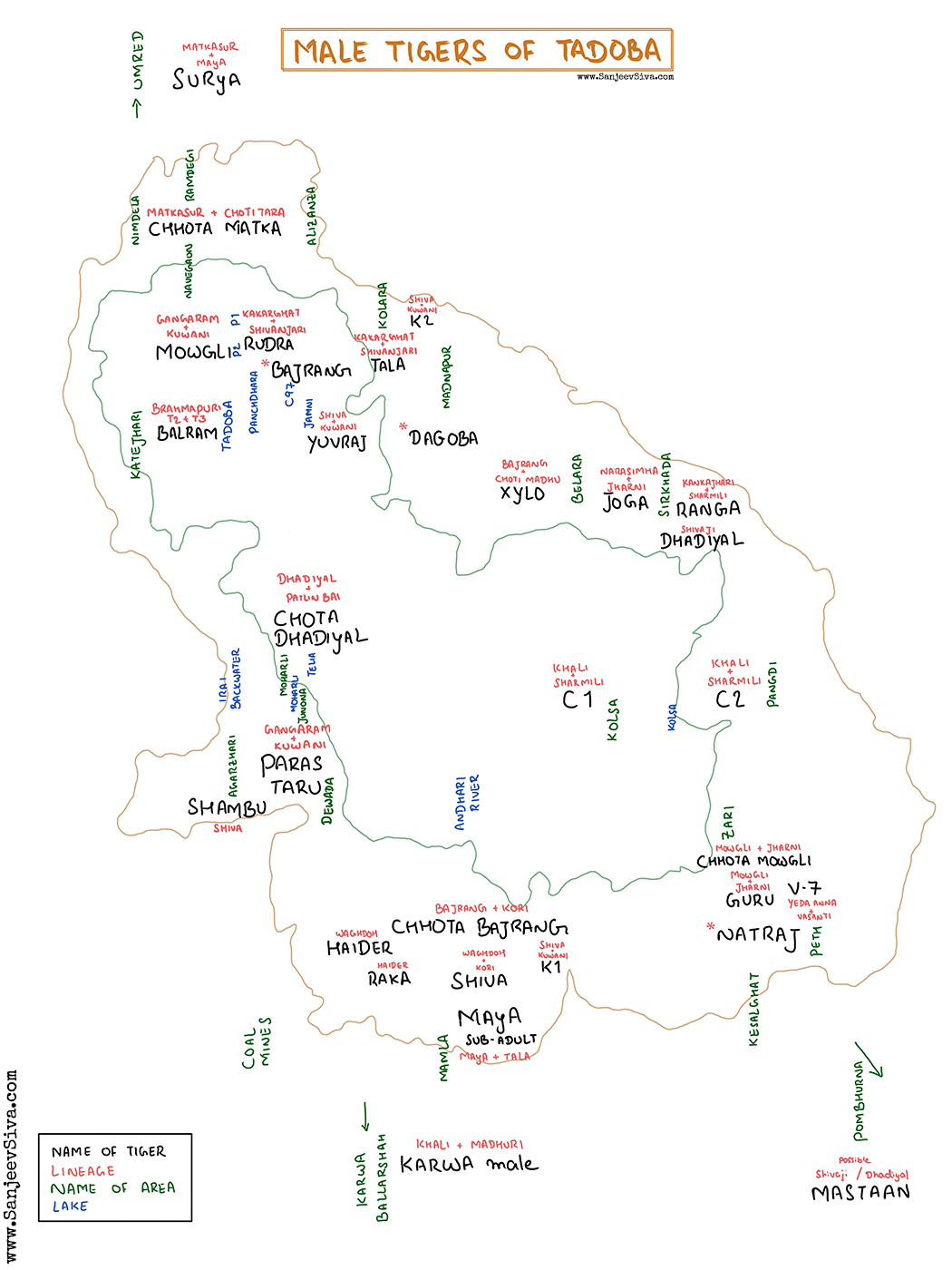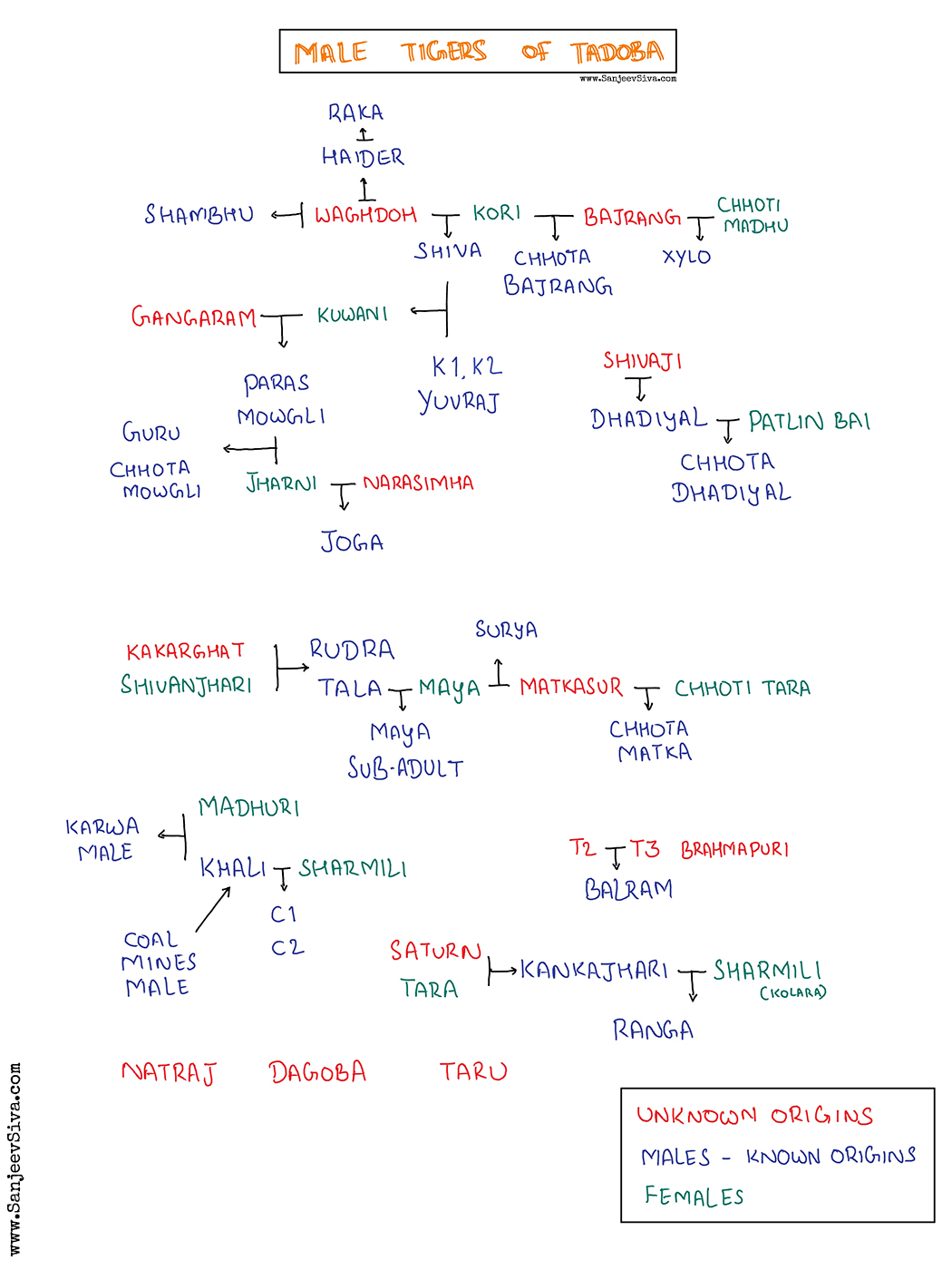Battlefields - 2 : Chhota Matka
“Wanna know how I got these scars?”, the Joker asked. The joker is a calculated antithesis, a manipulator who tricks others into thinking what he’s actually not, and that’s quintessential chicanery. Humans and tigers both fight in one common way – through deception; as the great Chinese strategist Sun Tzu puts it, ‘all warfare is based on deception’. When deception cannot win wars, wars are won by force; distilled by practice and time.
Tigers engage their opponents through acts of deception – advanced warfare technique. Firstly, tigers mark territories (by means of urine spraying, scraping etc) to keep wandering or intruding ones away. Secondly, when the territories overlap, tigers claw the trunks of the trees, sometimes by even climbing, to prove how menacingly tall they are, duping the other tiger. In addition to the visual message, chemicals such as pheromones are also deposited on the barks. Thirdly, in case of an engagement, a tiger will try to intimidate the opponent by flexing the muscles of the neck and shoulder, snarling and growling, standing on its hind legs, and launching a volley of punches and swipes at its opponent.
Most fights end at that point, but a few dominants take the warfare a little further. Life doesn’t matter to them as much as their thirst for power. The fight for supremacy puts the ultimate winner on the throne, deposing the loser.
The Tadoba range with its rich prey density and perennial and abundant water supply in certain pockets is a war-torn landscape. While elsewhere, a dominant tiger could rule for multiple years, say upto even a decade, the reign of a tiger in Tadoba is relatively short; thanks to the dominant males, each in a league of its own, waging wars to ascend the high seat of power.
From the earliest knowledgeable times, Tadoba range was ruled by kings from different dynasties. Each set is more deadly, ambitious and war mongering than the previous. Old Katezhari male, Hilltop male, W-male (Vasant Bhandara male) were followed by Saturn, Tyson, Gabbar, Narasimha. The next to arrive on the scene were Matkasur and Kali. They were then followed by Tala, Rudra, Mowgli, Chhota Matka, and Balram (with an overlap of reign)
The fight for the throne at the prey rich perennial Panderpauni lake heats up with the soaring temperatures. During summers, most tigers arrive at the lake, to lay their claim on the lake territory of Panderpauni and Tadoba. Numerous cubs and tigers have vanished without a trace; another good number of dominants have been badly injured or even killed. This also makes the reign unstable and perilous for the regnant queens (and the offspring).
At the peak of his reign, Matkasur ruled a territory bigger than that of any of his predecessor or successors. He mated with Choti Tara and two male cubs were born to the pair in the monsoon of 2016. No one knows the origins of Matkasur, but he apparently came from a different range, possibly Brahmapuri. Choti Tara, on the other hand, belonged to the circuit family of Moharli range, and hence, the cubs shared the best genetics, due to gene pool mixing.
Tigers are not instinctive animals. They learn – hunting or fighting – from the mother, father or even siblings. Despite their weight, the reaction time is quite fast for a tiger; this discerning ability not only makes a tiger a better hunter, but also enables the tiger to dodge swipes and strikes during a serious fight.
Thus, the playful fights that tigers indulge in during their formative months prepares them for future wars. It is not the strongest or the biggest of the tigers that have an advantage, in a fist fight; but the more agile ones and the resilient ones. The agile ones are prone to lesser injuries, and the resilient ones throw the challenge on a different day.
Growing up, Chhota Matka and Tara Chand, like all other tiger cubs, were involved in playful fights. The mother, Choti Tara is an expert huntress, and in the Jamni area where the two cubs were raised, there was no dearth of prey. The cubs slowly started to learn to hunt as well.
However, one incident changed the face of the future, literally for one of the cubs. In October of 2017, in one of the hunting sojourns, Chhota Matka was wounded badly, on the right abdominal flank; apparently slashed by a wild boar’s tusk. Though the mother would try to lick the wound (to heal), the forest department too tried to intervene and stitch up the deep cut. Tara Chand would step in and wouldn’t allow any vehicle or personnel get close to the injured Chhota Matka. The fraternal bond became stronger, and both almost never fought, even playfully, after this incident; the implications would strongly reflect on Chhota Matka in the future.
By June 2018, both these tigers were collared, as a part of the study to understand dispersal patterns – both the subadult male tigers would disperse sooner. However, Chhota Matka lingered in his father’s territory, while Tara Chand got electrocuted in a farm’s fence, in the buffer area of Moharli zone and died in December 2018. When they were collared, Tara Chand was the bigger tiger of the two – so a beautiful specimen was lost to human apathy.
A month prior, in November 2018, the Choti Tara subadults, Tara Chand and Chhota Matka met their father Matkasur, which probably caused them to move out of their natal territory. Around the same time, Matkasur escorted his other consort, Maya and her two cubs out of the territory to protect them from the subadults of Choti Tara.

Chhota Matka however remained in the same territory, occasionally bumping into Maya and other tigers. Matkasur was in his prime, but around the same time, there were other intruding males – Mowgli (from Kuwani family), Rudra and Tala (brothers from Shivanjari family) from Kolsa range. Skirmishes weren’t new for Matkasur, a seasoned warrior. He fought his battles with Gabbar and Kali, prior; and was badly injured in the process too. He would retreat to the buffer areas, where he would feed on easier prey (cattle) and would return with renewed vigor. But Matkasur couldn’t handle the heat from three males simultaneously, and he was finally dethroned in the late 2019.
The throne fell vacant with four males – Chhota Matka, Mowgli, Rudra and Tala trying to establish the territories and win over the queens – Choti Tara and Maya.
Chhota Matka’s younger years were fraught with bloody wars. The lack of playful fights with his brother, when they were young, meant that Chhota Matka didn’t have the practice to fight in real world.
Injuries to his paws and forelimbs were very common. More often than not, he was seen limping. He was one of the most handsome males with a fascinating jawline, trimmed ruff and scintillating blue eyes; most tigers in this region have pale yellowish to orangish eyes. But he would be disfigured for life soon, though his fighting spirit never died, and he struck back with vengeance, like a tiger possessed, and that would make him the supreme and undisputed ruler of his territory.
By the monsoons of 2021, Chhota Matka was mauled badly by Mowgli, a fight that disfigured him for life; Mowgli was ruling a sizeable portion of the North-Eastern part of Tadoba towards Alizanja and Kolara buffers.
And to add to the chaos, new tigers launch conquests for the coveted territory of Panderpauni-Tadoba lake area. A new tiger known as Balram, from Brahmapuri, entered the scene which only intensified the heat.
Like his father did, Chhota Matka fed on the cattle along the fringes and regained health quickly, and launched a spate of attacks on Mowgli, his prime nemesis. In April 2022, Chhota Matka had the upper hand; he injured and exiled Mowgli and claimed the entire territory of Mowgli. He later killed the cubs of Jharni, fathered by Mowgli, and she now has cubs of his own blood. He claimed two other females, Babli and Bhanushkindi, further promoting his bloodline.

Gentle and patient like his mother and dominant and territorial like his father, Chhota Matka is the biggest tiger of Tadoba and has the biggest territory of his contemporaries and rules like a king.
His scars are not only a reminder of his formative times, but also of his brutality, strength, strategy and his unquenchable thirst for power.
A look at his unfearful and glary bluish eyes and he would seem to ask “Wanna know how I got these scars?”. Beyond the scars, he is more affable than it seems. The rest as we know is history: his-story.

